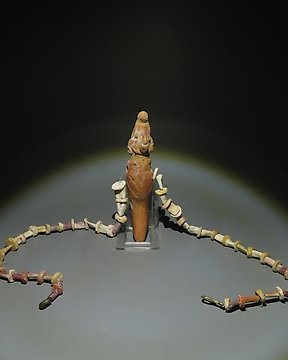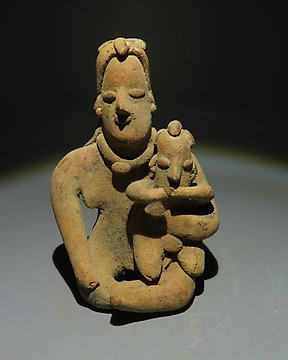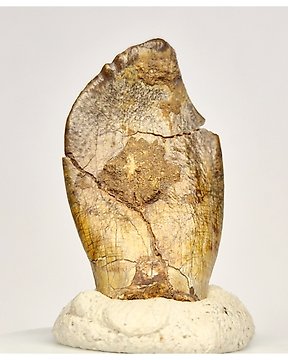Magnífica la entrega y el objeto. Perfecta la sonido del sibato
Se oversettelseTeotihuacan, Mexico, Terrakotta Veldig fin - Miniatyrmaske, klassisk periode, 200 - 700 e.Kr. 3 cm Høyde. Spansk importlisens
Nr. 88173067



Miniature mask.
- Nice Quality! -
Teotihuacan, Mexico, Classic Period, 200 - 700 AD.
Terracotta
3 cm height.
PROVENANCE: Private collection, Dijon, France.
CONDITION: Good condition. Without restorations.
BIBLIOGRAPHY:
- BERLO, J.C. (ed.). Art, Ideology, and the City of Teotihuacan. Dumbarton Oaks. 1992.
- BERRIN, K.; PASZTORY, E. (eds.). Teotihuacan: Art from the City of the Gods. Thames & Hudson. 1993.
- SCOTT, S. The Corpus of Terracotta Figurines from Sigvald Linne’s Excavations at Teotihuacan, Mexico (1932 & 1934-35). Ethnographical Museum of Sweden. 2001.
PARALLELS:
Fig. 1 Statuette of a seated figure. Teotihuacán, Mexico, 400-700 AD. Terracotta. Museo de América, Madrid, inv. 1985/01/133.
Fig. 2 Head. Teotihuacán, Mexico, 300-650 AD. Terracotta. Museum of Avila, Spain, inv. A/70/9.
Fig. 3 Articulated statuette. Teotihuacán, Mexico, AD 400-600. Terracotta. Los Angeles County Museum of Art (USA), inv. AC1996.146.47.
DESCRIPTION:
Terracotta head representing the face of a ruler or priest, adorned with large circular earflaps and with a shaved skull, noticeably wide, responding to some type of cranial deformation of ritual significance. The nose appears modeled naturally, as does the mouth with thick lips, while the eyes follow the more geometric coffee bean scheme typical of Teotihuacan figuration.
Teotihuacán was one of the largest cities in Mesoamerica during the Classic Period (ca. AD 200-600), a political, economic and religious centre with a multi-ethnic population of up to 100,000 inhabitants. It was located in the Central Highlands, within the Valley of Mexico, and its flourishing dates from approximately 150 BC to 700 AD. Its name means 'place where men become gods', as it was here that the teutl, the deified heroes, were buried.
Teotihuacán was a landmark in the millennia-long history of Mesoamerica; it was imposing in its scale and political and cultural importance, but also in its rigorous planning around religious buildings and the rites and ceremonies associated with them. Our current knowledge of the city is, however, limited; it has not been fully excavated, and many aspects of its culture have come down to us only through Aztec sources, unreliable because of their probable mythical and political motivations. It is therefore impossible to be sure that Teotihuacán directly controlled a territory, although its cultural and religious influence is evident in contemporary cities such as Tikal in Guatemala and Monte Albán in Oaxaca.
The end of the great city came around the year 700, after a period of political instability, internal social conflicts and climatic changes that affected the whole of northern Mesoamerica. Nevertheless, its ruins were a destination for explorers even before the Spanish conquest; Teotihuacán artefacts have been found at Toltec and Mexica sites to attest to this, and Postclassic Mexica mythology includes Teotihuacán as the setting for such fundamental myths as the legend of the Suns.
Teotihuacan terracotta statuettes are one of the most interesting artistic manifestations of what was the first of the great Mesoamerican cities. While their Zapotec and Mayan neighbours left portraits of their leaders and written chronicles, in Teotihuacan there are no historical representations within the ceremonial art, but an infinity of small figures and heads have been preserved which constitute an enormous source of information about the life and beliefs of the city's inhabitants. Intended for private worship and produced from an early date, these small terracottas evolved into increasingly dynamic and naturalistic forms; although they follow a general canon, they have innumerable variants that constitute a very rich iconography that has not yet been fully studied to this day. Some of the recurring features are the hybridisation of human and animal features, the repetition of certain clothing and ornaments suggesting affiliation to a particular social group, and even morphological details that could represent specific individuals.
Made by hand, moulded or a combination of both techniques, many of these statuettes are characterised by the schematic representation of the anatomy, which suggests that they may have originally been dressed (fig. 1). The faces of both the statuettes and the heads (fig. 2), on the other hand, show a greater level of detail. Many statuettes with articulated arms and legs have also been found (fig. 3), possibly also originally clothed. The abundance and variety of these pieces suggests the existence of a certain craft industry developed around the ceremonial centre of Teotihuacán, which must have exported its production beyond the city's territory, judging by the evidence from sites throughout Mesoamerica.
Notes:
- The piece includes authenticity certificate.
- The piece includes Spanish Export License.
- The seller guarantees that he acquired this piece according to all national and international laws related to the ownership of cultural property. Provenance statement seen by Catawiki.
Historien til selger
Miniature mask.
- Nice Quality! -
Teotihuacan, Mexico, Classic Period, 200 - 700 AD.
Terracotta
3 cm height.
PROVENANCE: Private collection, Dijon, France.
CONDITION: Good condition. Without restorations.
BIBLIOGRAPHY:
- BERLO, J.C. (ed.). Art, Ideology, and the City of Teotihuacan. Dumbarton Oaks. 1992.
- BERRIN, K.; PASZTORY, E. (eds.). Teotihuacan: Art from the City of the Gods. Thames & Hudson. 1993.
- SCOTT, S. The Corpus of Terracotta Figurines from Sigvald Linne’s Excavations at Teotihuacan, Mexico (1932 & 1934-35). Ethnographical Museum of Sweden. 2001.
PARALLELS:
Fig. 1 Statuette of a seated figure. Teotihuacán, Mexico, 400-700 AD. Terracotta. Museo de América, Madrid, inv. 1985/01/133.
Fig. 2 Head. Teotihuacán, Mexico, 300-650 AD. Terracotta. Museum of Avila, Spain, inv. A/70/9.
Fig. 3 Articulated statuette. Teotihuacán, Mexico, AD 400-600. Terracotta. Los Angeles County Museum of Art (USA), inv. AC1996.146.47.
DESCRIPTION:
Terracotta head representing the face of a ruler or priest, adorned with large circular earflaps and with a shaved skull, noticeably wide, responding to some type of cranial deformation of ritual significance. The nose appears modeled naturally, as does the mouth with thick lips, while the eyes follow the more geometric coffee bean scheme typical of Teotihuacan figuration.
Teotihuacán was one of the largest cities in Mesoamerica during the Classic Period (ca. AD 200-600), a political, economic and religious centre with a multi-ethnic population of up to 100,000 inhabitants. It was located in the Central Highlands, within the Valley of Mexico, and its flourishing dates from approximately 150 BC to 700 AD. Its name means 'place where men become gods', as it was here that the teutl, the deified heroes, were buried.
Teotihuacán was a landmark in the millennia-long history of Mesoamerica; it was imposing in its scale and political and cultural importance, but also in its rigorous planning around religious buildings and the rites and ceremonies associated with them. Our current knowledge of the city is, however, limited; it has not been fully excavated, and many aspects of its culture have come down to us only through Aztec sources, unreliable because of their probable mythical and political motivations. It is therefore impossible to be sure that Teotihuacán directly controlled a territory, although its cultural and religious influence is evident in contemporary cities such as Tikal in Guatemala and Monte Albán in Oaxaca.
The end of the great city came around the year 700, after a period of political instability, internal social conflicts and climatic changes that affected the whole of northern Mesoamerica. Nevertheless, its ruins were a destination for explorers even before the Spanish conquest; Teotihuacán artefacts have been found at Toltec and Mexica sites to attest to this, and Postclassic Mexica mythology includes Teotihuacán as the setting for such fundamental myths as the legend of the Suns.
Teotihuacan terracotta statuettes are one of the most interesting artistic manifestations of what was the first of the great Mesoamerican cities. While their Zapotec and Mayan neighbours left portraits of their leaders and written chronicles, in Teotihuacan there are no historical representations within the ceremonial art, but an infinity of small figures and heads have been preserved which constitute an enormous source of information about the life and beliefs of the city's inhabitants. Intended for private worship and produced from an early date, these small terracottas evolved into increasingly dynamic and naturalistic forms; although they follow a general canon, they have innumerable variants that constitute a very rich iconography that has not yet been fully studied to this day. Some of the recurring features are the hybridisation of human and animal features, the repetition of certain clothing and ornaments suggesting affiliation to a particular social group, and even morphological details that could represent specific individuals.
Made by hand, moulded or a combination of both techniques, many of these statuettes are characterised by the schematic representation of the anatomy, which suggests that they may have originally been dressed (fig. 1). The faces of both the statuettes and the heads (fig. 2), on the other hand, show a greater level of detail. Many statuettes with articulated arms and legs have also been found (fig. 3), possibly also originally clothed. The abundance and variety of these pieces suggests the existence of a certain craft industry developed around the ceremonial centre of Teotihuacán, which must have exported its production beyond the city's territory, judging by the evidence from sites throughout Mesoamerica.
Notes:
- The piece includes authenticity certificate.
- The piece includes Spanish Export License.
- The seller guarantees that he acquired this piece according to all national and international laws related to the ownership of cultural property. Provenance statement seen by Catawiki.
Historien til selger
- 825
- 10
- 1
very well packed with all the documents included, thnks
Se oversettelseGreat object. Really beautiful. Quick delivery. Excellent.
Se oversettelseSuperbe objet, Service d'Arqueologia Ancient Art excellent et rapide. Jaume Bagot toujours parfait .
Se oversettelseTodo perfecto gracias
Se oversettelseNice item all ok A+++
Se oversettelseThank you for this Oinochoe, one question: did you as promised read my post!
Se oversettelseVery cooperative in every aspect of the transaction.
Se oversettelseAlways a great pleasure!
Se oversettelseFine quality, good service. Thanks.
Se oversettelseMuy amables, muy bien todo. Gracias
Se oversettelseAlles bestens
Se oversettelseexactly as described and shipped safely and punctually.
Se oversettelseschnelle Lieferung sehr sichere Verpackung alles bestens
Se oversettelsetres bel objet je le recherchai depuis longtemps envoi rapide et protégé je pense qu'il y aura d'autres achats avec ce vendeur merci +++++++
Se oversettelseEinfach nur toll
Se oversettelseTodo perfecto
Se oversettelseottimo
Se oversettelseperfetto
Se oversettelsetop oggetto bellissimo grazie 💯💯💯💯💯💯 :-)
Se oversettelseI bought this beautiful artifact together with artifact from Mr. Bagot but although it is clearly stated on his shipping page that when purchasing multiple artifacts i paid the double package costs
Se oversettelseI bought this beautiful artifact together with artifact from Mr. Bagot but although it is clearly stated on his shipping page that when purchasing multiple artifacts i paid the double package costs
Se oversettelseBel objet, bien emballé. Parfait.
Se oversettelsewonderful faiece and very fast shipping.thanks a lot
Se oversettelseJ Bagot es un profesional excelente. Sus artículos son de gran calidad, se incluye la documentación necesaria y el embalaje se realiza con esmero. Le recomiendo encarecidamente.
Se oversettelse- 825
- 10
- 1
Magnífica la entrega y el objeto. Perfecta la sonido del sibato
Se oversettelseForbehold
Selger garanterer og kan bevise at objektet ble lovlig skaffet. Selger ble informert av Catawiki at de måtte skaffe dokumentasjonen som er påkrevd av lover og regler i deres bostedsland. Selger garanterer og har rett til å selge/eksportere dette objektet. Selger må skaffe all herkomst informasjon som er kjent for objektet til kjøper. Selger forsikrer at alle nødvendige tillatelser er/vil bli skaffet. Selger vil informere kjøper umiddelbart om det er forsinkelser ved å få tak i slike tillatelser.
Selger garanterer og kan bevise at objektet ble lovlig skaffet. Selger ble informert av Catawiki at de måtte skaffe dokumentasjonen som er påkrevd av lover og regler i deres bostedsland. Selger garanterer og har rett til å selge/eksportere dette objektet. Selger må skaffe all herkomst informasjon som er kjent for objektet til kjøper. Selger forsikrer at alle nødvendige tillatelser er/vil bli skaffet. Selger vil informere kjøper umiddelbart om det er forsinkelser ved å få tak i slike tillatelser.









